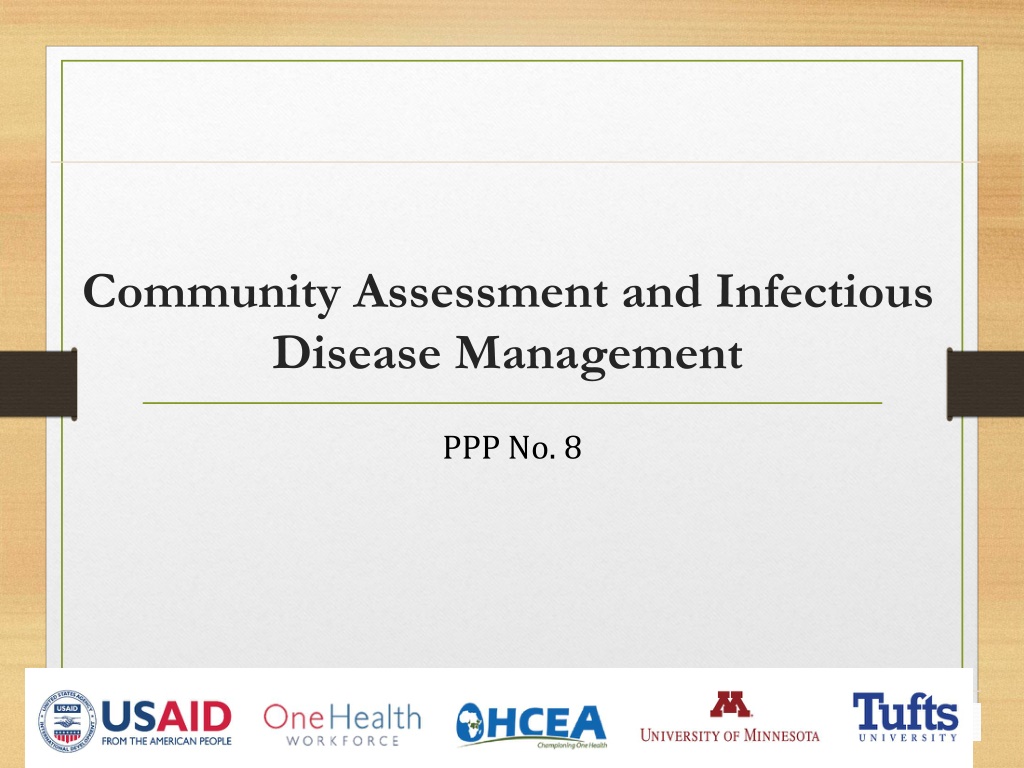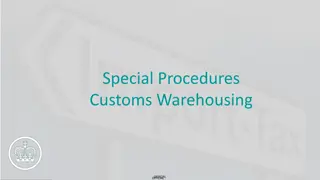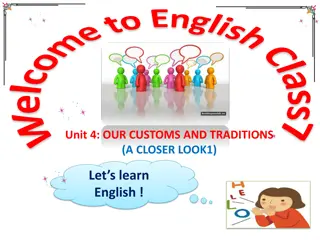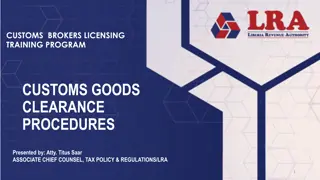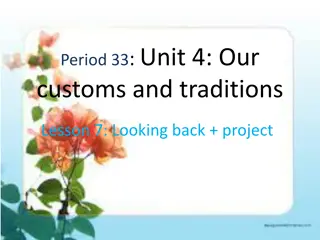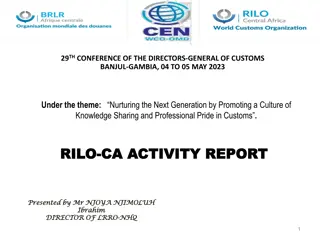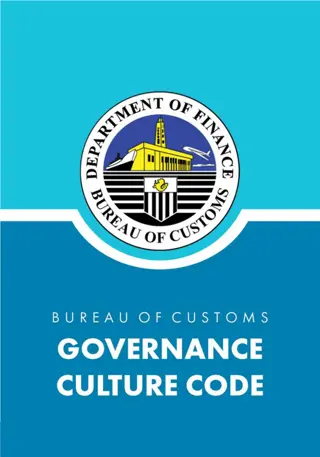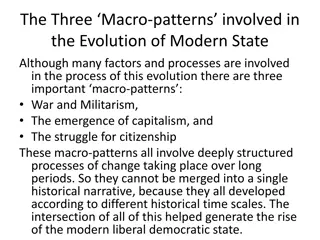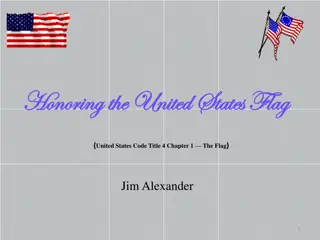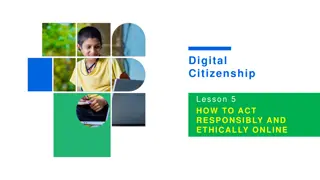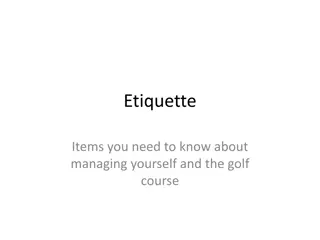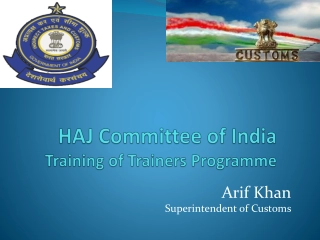Evolution of Etiquette: From Historical Customs to Modern Standards
Explore the evolving nature of etiquette, which has transitioned from rigid social hierarchies to a more inclusive and considerate set of guidelines reflecting changing societal norms. Etiquette serves as a means to show respect and consideration to others, emphasizing the importance of good behavior and cultural understanding.
Download Presentation

Please find below an Image/Link to download the presentation.
The content on the website is provided AS IS for your information and personal use only. It may not be sold, licensed, or shared on other websites without obtaining consent from the author. Download presentation by click this link. If you encounter any issues during the download, it is possible that the publisher has removed the file from their server.
E N D
Presentation Transcript
Community Assessment and Infectious Disease Management PPP No. 8
Working with your Team and Other People: Etiquette Contributer(s): Fredrick I. Kindi
Etiquette Meaning of Etiquette: It is a set of guidelines for politeness, good manners, and the kindnesses with which we should always treat each other It is guidelines which control the way a responsible individual should behave in the society It is the complex network of rules that govern good behavior and our social and community interactions!
Etiquette (2) In simpler terms etiquette is good behaviour which distinguishes human beings from animals. Thus, it reflects our cultural norms, generally accepted ethical codes, and the rules of various groups we belong to. It helps us show respect and consideration to others and makes others glad that we are with them. Without proper manners, the customs of polite society would soon disappear and we would act more like animals and less like people.
Evolving Nature of Etiquette Etiquette is always evolving and changing as society changes. Earlier times (Europe): the rules of etiquette were used for two purposes: to remind people of their own status within society to reinforce certain restrictions on individuals within that society. Middle Ages and the Renaissance: etiquette dictated everything from how low a person of inferior rank had to bow to a person of higher rank
Evolution of Etiquette These types of rules in earlier society were usually determined by the ruling classes because they served the purpose of making them more secure in their roles as the rulers of society. Over the centuries, as society changes, etiquette has become a combination of good manners, common sense, and rules of conduct that reflect cultural norms and the rules of our society. It has less to do with who is in power and more to do with putting others at ease and an ethical code of conduct.
Evolution Society and our culture are now changing so fast that it is hard for the rules of etiquette to keep up Note that etiquette is meant to be a guideline, not a set of strict rules carved in stone. Those guidelines are common sense, a politeness, and above all, consideration for others. developed sense using of fairness,
Importance of etiquette in today s society Etiquette makes one a cultured individual who leaves his mark wherever one goes. Etiquette teaches one the way to talk, walk and most importantly behave in the society. Etiquette is essential for an everlasting first impression. The way you interact with your superiors, parents, fellow workers, friends speak a lot about your personality and up- bringing.
Importance Etiquette enables the individuals to earn respect and appreciation in the society. No one would feel like talking to a person who does not know how to speak or behave in the society. Etiquette inculcates a feeling of trust and loyalty in the individuals. It makes good first impressions. The first five to seven seconds after you meet someone are crucial. Your first impression lingers in the other person's mind long after you are gone. If you use proper etiquette, that first impression will be a positive one.
Importance It makes communication clearer. Etiquette enhances communication by breaking down barriers, not erecting them
Types of etiquette Social etiquette: how to behave in society Meeting etiquette: behavior in meeting, seminar, presentation; don t go to a meeting without a notepad & a pen; listen to what others say Telephone etiquette: the way one speaks on the phone Bathroom etiquette Eating etiquette
Community Entry, Stay, Exit & Return Contributer(s): Justus Twesigye
Tool Box or 10 Commandments Dos and Don ts No simple tool kit is available for effective community entry, stay, exit and return Be a good human being and an excellent learner
Language Translation Dire Consequences? A researcher sent a team of assistants to collect data in a community that was engaged in a protracted conflict over a forest reserve between community members and Government, Rumor had it that Government planned to send surveyors to demarcate land and to arrest encroachers on the forest reserves
The research assistants grew up in the city, speaking English and therefore not fluent in the local language. They could not correctly translate the survey tool. When asked by the suspicious community members what they needed in the community, one research assitant stammered turi aba surveyor; turenda You can imagine what followed
HALO EFFECT First and last impressions matter more than other impressions What really counts Vs what catches the eye
Tarmac Road Bias Intervention areas are often selected because they are easily accessible by a car. Such areas are likely to be systematically different from those that are not accessible. Rural development tourism which may involve e.g photo opportunities with unusual people and any other forms of opportunistic interactions.
Assessment not Diagnosis Assessment aims at understanding or knowing at a level greater that measuring and diagnosing, which are based based on medical or the positivistic model of a linear cause and effect relationship. Assessment shifts from emphasis on problems to assets, capacity and problem-solving
Intervene not interfere Community health workers must run themselves out of jobs so that community members manage their daily lives Community interventions may be intrusive and disruptive towards routines, and can also undermine community s agency for self- determination and direction. If you want man to eat fish for a day, give him fish and you want man to eat fish for the rest of his life, teach him how to fish
Community Participation Empower communities to be in charge of their lives, promote social inclusion and solidarity. Facilitate communities to be in charge of their own welfare Beware of a rescuer s fantasy
Self-fulfilling Prophecy Community health workers are often inclined to find what they are looking for People s preconceived expectations and beliefs determine their behavior, thus, serving to make their expectations come true
Critical Perspective and Consciousness Community members need baskets and not packages of health interventions. Community health workers should do more than providing technical interventions e.g by sharing with the community value commitments and societal goals
Diversity and Uniqueness Tolerate differences especially between community health workers and community members People may not share the same constructions of reality because of differences in ideologies, values and pragmatic interests Be mindful of intra-group diversity eg age, gender, class differences which if not acknowledged may hinder teamwork and lead to burn out
Respect and Responsiveness Respect community members enough to seek and listen to their views
Community Engagement Contributor(s): Fredrick Immanuel Kindi
What is Engagement? Engagement means many things including: consultation communication public participation working in partnership
What is Engagement? For our purposes, 'engagement is a generic inclusive term to describe the broad range of interactions between people. It can include a variety of approaches such as: one-way communication or information delivery consultation involvement and collaboration in decision-making empowered action in informal groups or formal partnerships
Community Community' is a broad term used to define groups of people sharing something in common, either as stakeholders or interest groups, etc. A community may be: a geographic location-where a particular group(s) of people stay a community of similar interest education community, business community, etc a community of affiliation or identity gay community, lesbian community, etc
Community Whether or not a community is defined geographically, it still has a geographic context -- a setting that it exists in. It is very important to understanding this setting. You have to get to know its people -- their culture, their concerns, and relationships -- and to develop your own relationships with them as well.
Issues to understand Physical aspects. Topography, its size and buildings The physical properties also define the population: where they live, where they gather, the places that are important to them. The characteristics of those places can tell you a great deal about the people who make up the community.
Issues to understand Infrastructure. Roads, transportation (bicycles, mopeds , taxis, electricity, mobile telephone service. Patterns of settlement, commerce, and industry. Communities reveal their character by where and how they create living and working spaces.
Issues to understand Demographics. It's vital to understand who makes up the community. Age, gender, and ethnicity, marital status, education, number of people in household, language(s) History. The history of the community can tell you about community traditions, what the community is, or has been, proud of, and what residents would prefer not to talk about.
Issues to understand Community leaders, formal and informal Community culture, formal and informal. This covers the spoken and unspoken rules and traditions by which the community lives Existing groups. Most communities have an array of groups and organizations of different kinds -- faith groups, youth organizations, sports teams and clubs, groups formed around shared interests, etc
Issues to understand Attitudes and values What does the community care about, and what does it ignore? What are residents' assumptions about the proper way to behave, to dress, to do business, to treat others? Is there widely accepted discrimination against one or more groups by the majority or by those in power?
Importance of Taking Time to Understand the Community Gaining a general idea of the community's strengths and the challenges it faces. Capturing unspoken, influential rules and norms. For example, if people are divided and angry about a particular issue, your information might show you an event in the community's history that explains their strong emotions on that subject.
Importance of Taking Time to Understand the Community Getting a feel for the attitudes and opinions of the community when you're starting work on an initiative. Ensuring the security of your organization's staff and participants.
Importance of Taking Time to Understand the Community Providing background and justification for grant proposals. Knowing the context of the community so that you can tailor interventions and programs to its norms and culture, and increase your chances of success.
Community Engagement A planned process with a specific purpose of working with identified groups of people, whether they are connected by geographic location, special interest, or affiliation or identify to address issues affecting their well-being.
Form of community engagement Informing the community of policy directions of the government. Consulting the community as part of a process to develop government policy, or build community awareness and understanding. Collaborating with the community by developing partnerships to formulate options and provide recommendations.
Planning To Engage With The Community Informing the community of policy directions of the government. Consulting the community as part of a process to develop government policy, or build community awareness and understanding. Collaborating with the community by developing partnerships to formulate options and provide recommendations.
Identification of Stakeholders It will be essential to utilise a range of mechanisms and avenues to identify all the relevant stakeholders. Mechanisms such as Local community development networks organisations should identifying community their particular interests and needs and how best to engage with them and involved stakeholders, support be in
Range of stakeholders Local Residents A Community of Interest group Faith Based Groups Ethnic and Cultural Groups
Principles Of Community Engagement Be clear about the purposes and scope of the engagement and the populations you want to engage. Become knowledgeable about the community s culture, economic conditions, social networks, political and power structures, norms and values, demographic trends, history,. Learn about the community s perceptions of those initiating the engagement activities.
Principles Of Community Engagement Go to the community, establish relationships, build trust, work with the formal and informal leadership, and seek commitment from community organizations and leaders to create processes for mobilizing the community. Remember and accept that collective self- determination is the responsibility and right of all people in a community. No external entity should assume it can bestow on a community the power to act in its own self-interest.
Principles Of Community Engagement Partnering with the community is necessary to create change and improve health All aspects of community recognize and respect the diversity of the community. Awareness of the various cultures of a community and other factors affecting diversity must be paramount in planning, designing, and implementing approaches to engaging a community. engagement must
Principles Of Community Engagement Community engagement can only be sustained by identifying and mobilizing community assets and strengths and by developing capacity and resources to make decisions and take action. Organizations that wish to engage a community as well as individuals seeking to effect change must be prepared to release interventions to the community and be flexible enough to meet its changing needs. the community s control of actions or
Principles Of Community Engagement Community collaboration requires long- term commitment by the engaging organization and its partners
Participatory Methodologies Contributer(s): Dr Brigitte Bagnol
Participatory Rural Appraisal (PRA) incorporates the knowledge and opinions of rural people in the planning and management of development projects and programmes. Participatory Epidemiology (PE) is the study with the stakeholders of the distribution and patterns of health-events, health-characteristics and their causes. Participatory Impact Assessment (PIA) focuses on enabling the poor to voice their views about impact.
Why participatory methods? It allows the development of a learning partnership with male and female respondents It creates space for dialogue to assess the results and discuss how future activities and allocation of resources can be improved.
